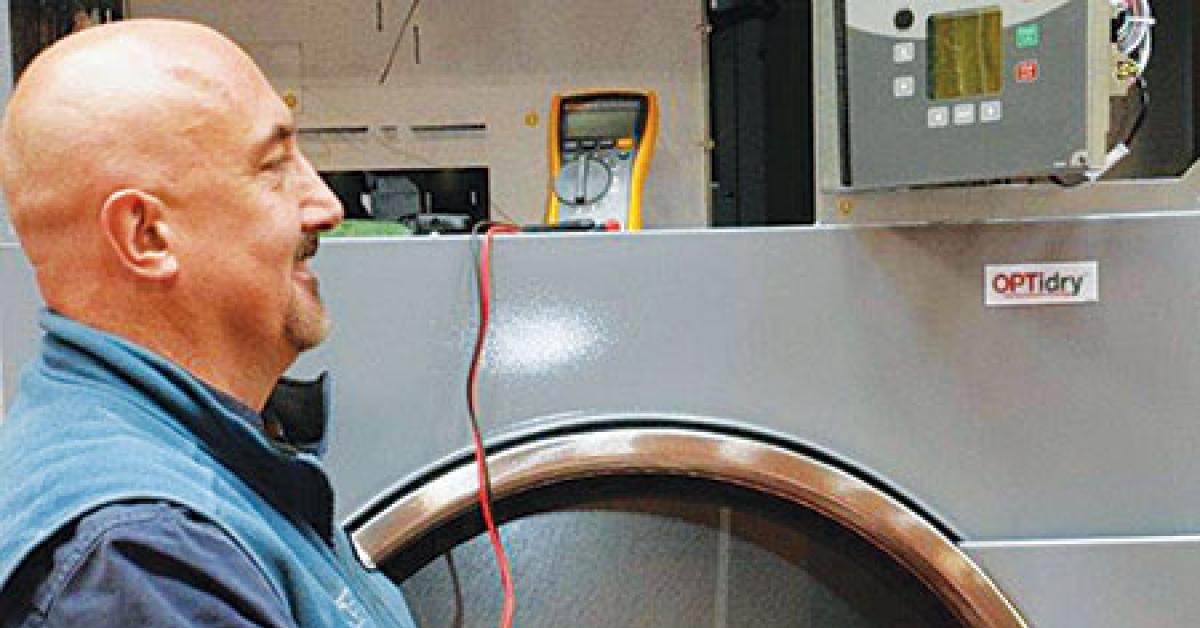RIPON, Wis. — Technology plays a significant role in not only running today’s on-premises laundry (OPL) operation, but also keeping machine downtime, labor and utility costs as low as possible.
OPL managers aim to run their operations at peak efficiency, and with the right equipment, technology and distributor support, this goal is more than manageable. Here’s what you need to know.
KEEP UP WITH PREVENTATIVE MAINTENANCE
All washers and dryers in an OPL should be monitored and serviced regularly to ensure they’re running at their optimal efficiency. Frequent preventative-maintenance checks help OPL managers avoid costly repairs down the road when small issues multiply and can create bigger problems. Your distributor should be able to work with you to determine and set up an automated maintenance schedule to monitor equipment aspects such as fill temperatures, water leakage and bearing grease.
While there are several methods to keep track of equipment maintenance, the easiest and most efficient way is through the technology and software included in your machines. It has the ability to monitor everything from cycle times to number of fills, number of drains to water temperature, idle time and more. This information is then used to alert laundry-room operators when service is needed. For example, machine bearings should be greased every 200 operating hours; advanced equipment can send the operator an alert when the 200 hours have been reached and the bearings need to be greased.
“The biggest single maintenance cost on a washer is replacement of bearings,” says Dave Angus, technical service supervisor, Daniels Equipment Co., a UniMac distributor located in Auburn, N.H. “If you don’t stay up to date with greasing your machine’s bearings, you will have to replace them much sooner.”
Leak-detection tests should also be run regularly to ensure laundry machines are not wasting water or increasing utility bills and cycle times. A washing machine should be able to run self-diagnostic leak-detection tests automatically, at a pre-set time or after a set number of cycles, without stopping or disrupting the work flow of a laundry operation. The technology will ensure all water and drain valves are working properly and display a message if any issues are discovered. Water leakage can be a problem that flies largely under the radar if regular tests are not performed. Sometimes the only indication of water loss is longer cycle times—as the washer will automatically refill the water it has lost—or higher utility bills.
“We recommend conducting leak-detection tests once per week,” says Ralph Daniels, president of Daniels Equipment Co. “In our experience, early detection of water waste can save hundreds of thousands of gallons of water per year.”
TAKE ADVANTAGE OF ADVANCED REPORTING CAPABILITIES
OPL managers can quickly run electronic reports that detail the inner workings of laundry equipment and operations on a daily, weekly, monthly, quarterly and annual basis. Additionally, the results of these reports can be compiled and accessed electronically, which eliminates the need to store lengthy manuals and checklists. These reports can determine aspects of the laundry process as precise as cycle temperatures, which is necessary to confirm proper temperatures were achieved for chemical interaction, cleaning and safety.
Machine technology can monitor everything from aborted cycles to rapid cycles to idle time between loads, which can all impact a laundry operation’s labor costs and bottom line. The best technology can tell the difference between equipment problems and issues with the laundry process, so operating issues are not redirected as maintenance issues. This gives OPL managers a better understanding of what’s happening in their laundry room—even if they’re not physically present—and the ability to set benchmarks to improve efficiency.
UTILIZE TECHNOLOGY TO ADDRESS MAINTENANCE NEEDS
When a machine issue does arise, technology can quickly diagnose the problem and expedite the solution. The most advanced equipment is able to determine the source of a problem immediately and send a service alert message to the operator.
“The alert is enough to ensure a rather prompt response from the staff due to its persistence,” says Brad Reichenbach, regional field service manager for UniMac.
For example, when an issue with moisture-sensing technology arises in a tumble dryer, an alert will pop up on the control that asks the operator to confirm that a load is in the dryer. When a dryer does not obtain a moisture reading in the cylinder while a load is in progress, it instantly identifies that the moisture-sensing circuit is not working.
These alerts are crucial to helping OPL managers and staff technicians diagnose problems with their equipment, as well as determine the best way to fix them to prevent downtime. With the advanced controls on today’s machines, OPL staff is able to test inputs and outputs without having to open the machine up and do traditional parts or circuitry testing. Diagnostic testing can be done from a computer, which requires less time than taking a machine apart. According to Daniels, this can save 20-30% on labor hours and service calls.
Check back Thursday for the conclusion.
Have a question or comment? E-mail our editor Matt Poe at [email protected].
